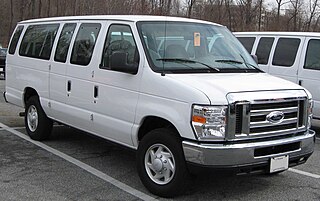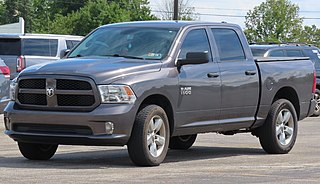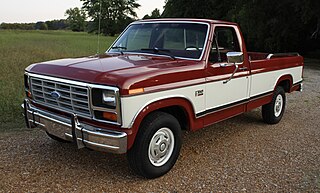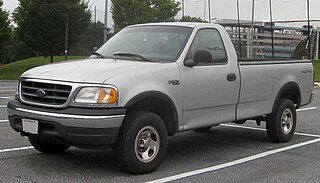
The Ford E-Series is a range of full-size vans manufactured and marketed by the Ford Motor Company. Introduced for 1961 as the replacement of the Ford F-Series panel van, four generations of the model line have been produced. Marketed for both cargo and passenger transport configurations, the E-Series has been designed with multiple design variations for both retail and commercial sale, including vans, and commercial-grade cutaway van chassis and stripped chassis.

The Ford F-Series is a series of light-duty trucks marketed and manufactured by Ford Motor Company since the 1948 model year. The F-Series is marketed as a range of full-sized pickup trucks positioned above the midsize Ranger but below the larger Super Duty in the Ford truck lineup. Alongside the F-150, the F-Series also includes the Super Duty series, which includes the heavier-duty F-250 through F-450 pickups, F-450/F-550 chassis cabs, and F-600/F-650/F-750 Class 6–8 commercial trucks.

The Ford Excursion is a heavy-duty SUV that was sold by Ford Motor Company from 2000 to 2005. At the time of its introduction, the Excursion was the longest and heaviest SUV ever to enter mass production. The third Ford SUV derived from the F-Series pickup trucks, the model line used a heavier-duty chassis and frame than the Expedition; both vehicles competed against the Chevrolet Suburban.

The Ram pickup is a full-size pickup truck manufactured by Stellantis North America and marketed from 2010 onwards under the Ram Trucks brand. The current fifth-generation Ram debuted at the 2018 North American International Auto Show in Detroit, Michigan, in January of that year.

The Dodge Power Wagon is a four-wheel drive medium duty truck that was produced in various model series from 1945 to 1980 by Dodge. The Power Wagon name was revived for the 2005 model year as a four-wheel drive version of the Dodge Ram 2500. As a nameplate, "Power Wagon" continues as a special package of the four-wheel drive version of 3/4 ton Ram Trucks 2500 model.

The Ford Explorer Sport Trac is a pickup truck that was manufactured and marketed by Ford Motor Company for the North American market. The first mid-sized pickup truck produced by Ford, the Sport Trac was marketed from the 2001 to the 2010 model years. Sized between the Ranger and the F-150, the Sport Trac largely competed against crew-cab variants of the midsize Chevrolet Colorado/GMC Canyon, Dodge Dakota, Nissan Frontier, and Toyota Tacoma.

The Ford Super Duty is a series of heavy-duty pickup trucks produced by the Ford Motor Company since the 1999 model year. Slotted above the consumer-oriented Ford F-150, the Super Duty trucks are an expansion of the Ford F-Series range, from F-250 to the F-600. The F-250 through F-450 are offered as pickup trucks, while the F-350 through F-600 are offered as chassis cabs.

The International Extreme Truck Series is a range of pickup trucks produced by Navistar International from 2004 to 2008. The first International-brand vehicle marketed for non-commercial sale since 1980, the XT line also marked the return of the company to pickup truck production since the final generation of the (smaller) Light Line pickup trucks in 1975.

The Ford L-series is a range of commercial trucks that were assembled and marketed by Ford between 1970 and 1998. They are also known as Ford Louisville or, for the 1990s aerodynamic models, Ford Aeromax. The first dedicated Class 8 truck produced by the company, although Ford had been producing "Heavy Duty" trucks since 1948 and their "Super Duty" lineup since 1958. The L-Series was the successor of the F-900/F-1000 Super Duty and the Ford N-Series. The line encompassed a wide range of models in GVWR Classes 6 through 8, as either straight trucks or as semi-tractors, with vehicles developed for medium-duty, on-highway, severe-service, and vocational applications.

The twelfth generation of the Ford F-Series is a light-duty pickup truck that was produced by Ford from the 2009 to 2014 model years. Initially slotted between the Ford Ranger and Ford Super Duty in size, the F-150 became the smallest Ford truck in North America following the 2011 withdrawal of the Ranger. The final generation of the F-150 produced with a separate body design from the Super Duty trucks, the twelfth generation again adopted an all-new chassis and body, also marking an extensive transition to the powertrain lineup.

The third-generation of the Ford F-Series is a series of trucks that were produced by Ford from 1957 until 1960. Following its competitors at Dodge and General Motors, Ford widened the front bodywork to integrate the cab and front fenders together. Going a step further, the F-Series integrated the hood into the bodywork with a clamshell design; the feature would stay part of the F-Series for two decades. Although offered previously, the optional chrome grille was far more prominent than before. In the rear, two types of pickup boxes were offered, starting a new naming convention: the traditional separate-fender box was dubbed "Flareside", while "Styleside" boxes integrated the pickup bed, cab, and front fenders together. As before, Ford still offered a low-GVWR version of each model.

The fourth generation of the Ford F-Series is a line of trucks produced by Ford from the 1961 to 1966 model years. Introducing a lower and wider cab over the previous generation, Ford introduced several design changes to the model line. In line with modern pickup trucks, the bed sides, hood line, and window sill were all the same height. Ford returned the F-Series to two headlights.

The fifth generationof the Ford F-Series is a line of pickup trucks and commercial trucks that were produced by Ford from the 1967 to 1972 model years. Built on the same platform as the fourth generation F-Series, the fifth generation had sharper styling lines, a larger cab, and expanded engine options.

The sixth generation of the Ford F-Series, also known as the "dentside Ford" to enthusiasts, is a line of pickup trucks and medium-duty commercial trucks that were produced by Ford Motor Company from the 1973 to 1979 model years. Produced by Ford in North America, Argentina, and Australia, this is the third and final generation of trucks derived from the 1965 Ford F-Series.

The seventh generation of the Ford F-Series is a range of trucks that was produced by Ford from the 1980 to 1986 model years. The first complete redesign of the F-Series since the 1965 model year, the seventh generation received a completely new chassis and body, distinguished by flatter body panels and a squarer grille, earning the nickname "bullnose" from enthusiasts. This generation marked several firsts for the model line, including the introduction of the Ford Blue Oval grille emblem, the introduction of a diesel engine to the model line, and a dashboard with a full set of instruments (optional). Conversely, this generation marked the end of the long-running F-100, the Ranger trim, and sealed-beam headlamps.

The ninth generation of the Ford F-Series is a lineup of trucks that were produced by Ford from the 1992 to 1998 model years. The final generation of the F-Series to include a complete range of trucks from a half-ton F-150 pickup truck to a medium-duty F-800 commercial truck, this is the third generation of the F-Series body and chassis introduced for 1980.

The tenth generation of the Ford F-Series is a line of pickup trucks produced by Ford Motor Company from the 1997 to 2004 model years. The first ground-up redesign of the F-Series since 1979, the tenth generation saw the introduction of an all-new chassis and a completely new body. In a significant model change, the tenth generation was developed only for the F-150, with the ninth-generation F-250 and F-350 replaced by the all-new Ford Super Duty variant of the F-Series for 1999. An all-new crew-cab configuration debuted in 1999 for the 2001 model year.

The eleventh generation of the Ford F-Series, marketed as the Ford Lobo in Mexico, is the company's line of light-duty pickup trucks manufactured and marketed by Ford for the 2004 to 2008 model years. With a redesigned body and chassis, and marketed as its F-150 line, between the company's Ranger and the Super Duty trucks.

The fourteenth-generation Ford F-Series is a range of pickup trucks produced by Ford, introduced for the 2021 model year. This was the first generation to include a fully-electric and hybrid pickup truck among the offerings, with the F-150 Lightning EV having entered production in 2022. The F-150 positioned above the midsize Ranger but below the larger Super Duty in the Ford truck lineup.

The fourth generation of the C/K series is a range of trucks that was manufactured by General Motors. Marketed by the Chevrolet and GMC brands from the 1988 to the 2002 model years, this is the final generation of the C/K model line. In a branding change, GMC adopted the GMC Sierra nameplate for all its full-size pickup trucks, leaving the C/K nomenclature exclusive to Chevrolet.
























